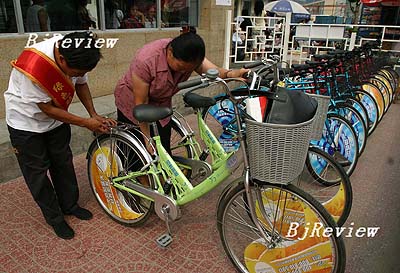|

Commuters on Beijing's city rail transport system received a gift from the Beijing Municipal Government on October 7, the last day of the seven-day National Day holiday. From the first working day on October 8, the price of a single unlimited length journey dropped from five yuan to two. The drop brought the a price of a ticket down to the lowest in the country, just 0.5 yuan short of the price of a McDonald's ice cream cone.
Even better news for commuters was the opening of a 27.6-km new subway line on October 7 after nearly five years' construction. The north-south underground artery goes through the city center and links a 400,000-people mega residential area in the northern suburbs with other parts of the city. Nearly 200,000 commuters living along its route now enjoy the convenience brought by the new line and its modern facilities that include LCD screens in subway cars and full cell phone signal coverage, even in the subway tunnels. Their daily commuting time has also been shortened by up to one third.
Beijing already had the cheapest bus fares in China, just 0.2 yuan. Starting from January 1, 2007, all adult bus passengers received a 60-percent discount and students an 80-percent discount if they pay for their journeys using a prepaid IC card on any bus line in the city. To guarantee the implementation of this discount policy, the municipal government arranged a 1.3-billion yuan subsidy to the city's bus companies.
Reassuring the public that bus and subway fares won't be raised after the Olympic Games at a public hearing in September, the Beijing Municipal Commission of Development and Reform announced that low-price public transport is a long-term strategy to encourage people out of their cars.
As the Olympics approaches, Beijing is investing generously in public transport, with the intention of both easing traffic congestion and helping to clear air pollution. The city authorities hope that policies enacted now will continue to benefit Beijing long after the Olympic torch has left town.
According to a "public transportation first plan" issued by the Beijing Municipal Government at the end of last year, the development of public transport will be given land use priority and financing.
Mass rail transit system
Figures from the Beijing Municipal Committee of Communications show that Beijing has invested 30 billion yuan in public transport in the last three years. Investment between 2006 and 2010 is expected to reach 71.5 billion yuan.
A large proportion of government investment will be used for constructing Beijing's city rail network. By 2015, Beijing will have 561 km of rail lines in operation, a substantial increase from the current 142 km, making it the city with the longest rail tracks in the world.
By the end of this year, the simultaneous construction of eight subway lines will start, including Line 4, Line 10 and the airport line. Of them, the airport line will be completed in 2008 in time for the Olympic Games and Line 4 is scheduled to open to the public in 2009. The remaining six subway lines are all scheduled to be finished in 2012. By 2015, residents within Beijing's Third Ring Road will be able to enter a subway station within one km of home.
"Daily passenger numbers on the city rail network will increase from the current 2.2 million to 8 million, supporting 23 percent of the city's total transportation load," said Liu Xiaoming, deputy head of the Beijing Municipal Committee of Communications.
Car ownership
Over 1,000 new cars hit the road in Beijing every day and experts say growth momentum remains strong in the foreseeable future. The
| 